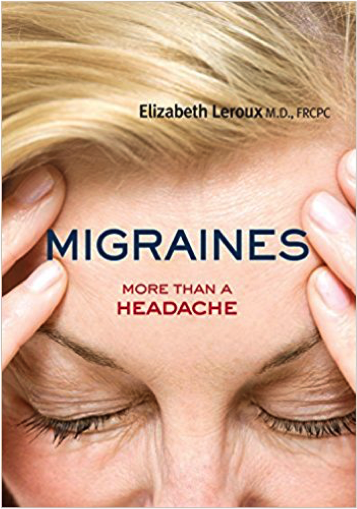Elizabeth Leroux, MD, FRCPC – Migraines

Elizabeth Leroux, MD, FRCPC
Clinical Assistant Professor Neurology, Department of Clinical Neurosciences, University of Calgary
bh in Brief
Elizabeth Leroux received her neurology training at the University of Montreal and completed a two-year fellowship at the Emergency Headache Center of Hopital Lariboisiere in Paris, doing research mainly on cluster headaches. She was director of the Headache Clinic at Hospital Notre-Dame (Montreal University Hospital) from 2010 to 2016. In 2017, she was appointed Headache Leader of the CHAMP program at the University of Calgary.
Dr Leroux is the vice-president of the Canadian Headache Society, the founder of the Migraine Quebec website and association, and an advocate for headache patients. Her current interests include therapeutic education for migraine and cluster headaches. Her book for general readers, Migraines: More than a headache, is available in French, English and Mandarin.

References
7. Young WB, Park JE, Tian IX, Kempner J. The stigma of migraine. PLoS One. 2013;8:e54074.
8. Charles A. Migraine. N Engl J Med. 2017;377:1698-1699.
9. Pringsheim T, Davenport W, Mackie G, et al. Canadian Headache Society guideline for migraine prophylaxis. Can J Neurol Sci. 2012;39:S1-59.
10. Worthington I, Pringsheim T, Gawel MJ, et al. Canadian Headache Society Guideline: acute drug therapy for migraine headache. Can J Neurol Sci. 2013;40:S1-s80.
11. McLean A. Supporting individuals with migraine in the workplace. Work (Reading, Mass). 2009;34:123-127.
“Migraine patients deserve respect and consideration.”
What is migraine?
Migraine is a neurological disease. A migraine attack is a combination of different symptoms including pain, nausea, hypersensitivity to light, sounds and smells. It is a chemical and electrical cascade of events in the brain that cannot be seen on current imaging tests, although brain abnormalities have been demonstrated in research.8 Migraine is the third most common disease in the world. Four times more women than men experience migraine, 15% of adults and 10% of children.
How is migraine currently treated?
There is no cure and, since migraine varies from person to person, there is no one-size-fits-all approach. Treatment involves a combination of behavioral adaptations to manage triggers, acute medications to abort attacks, and preventive medications to decrease attack frequency and severity. It begins with appropriate evaluation and correct diagnosis. A good therapeutic plan should be adapted to the global medical picture of the person. Treatment may also need to be adapted as migraine severity may vary over the lifetime. Making lifestyle adaptations to cope with migraine is a long process and can be frustrating for the individual wanting to live “normally.” Many migraine sufferers or migraineurs must endure multiple failures and side effects before finding an appropriate medication.
What is the cause of migraine?
Migraine is determined in great part by many different genes, and these multiple genes probably explain the wide variability of this disease. Science has shown that the migraine brain is objectively different from the normal brain in many aspects. It has a low serotonin state and it is electrically hyperreactive. We cannot change genes. We can, however, decrease the brain’s predisposition to trigger migraines and interrupt the migraine cascade that leads to an attack.
To treat an attack, anti-inflammatories act on inflammation and triptans act on serotonin. Available preventives are much less specific and were developed for other diseases like hypertension or depression.9, 10 We know now that one of the key substances active during the migraine attack is called CGRP. Blocking CGRP leads to fewer migraine attacks. Antibodies that block CGRP or its receptor have been developed and are expected to become available in Canada soon. For the first time in migraine prevention history, a treatment will target one of the causes of the problem. Other therapeutics are also under investigation. The future is promising.
How does migraine affect individual employees in the workplace?
During an attack, brain function is impaired, and that can be very disabling. Different symptoms can lead to different impairments. The pain itself usually prevents patients from concentrating or engaging in social interactions. Cognitive function can be impaired as well. Medications may have side effects such as drowsiness and cognitive difficulties. Visual aura prevents any activity requiring reading or visual tracking. Vestibular attacks may impair balance and lead to severe nausea. In a study on stigma and migraine, 75% of episodic migraineurs and >90% of chronic migraineurs reported that migraine had an impact on their work.7
What can employers do?
Migraine patients deserve respect and consideration. Employers willing to be proactive can accommodate sufferers by reducing migraine triggers, being flexible, and adopting supportive benefit and disability policies.11 They can also be a positive influence in the workplace and encourage managers and other employees to reduce stigma and help sufferers overcome the isolation that may prevent them from seeking care. Their goal should be to eliminate discrimination and empower migraineurs to become more productive employees with a greater sense of their own well-being. bh
|
From the Introduction to More than a Headache … …We don’t yet have a treatment to cure migraine, but we can at the very least change our perception of the disease and stop doing harm to those who have it by refusing to recognize their symptoms. To change our perception, destroy taboos, and deconstruct myths, we have to explain it to people, we have to educate them. We have to help people understand. And understanding a neurological problem like this one is quite a challenge. This is the challenge I’m trying to meet by writing this book. By presenting scientific knowledge in lay terms, I’ll outline what we in the medical community know, so that migraine sufferers and those close to them can also understand this disease. Published by Dundurn Press. Available at Chapters.Indigo.ca and Amazon.ca. |

